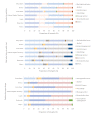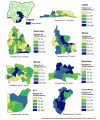Key Population Hotspots in Nigeria for Targeted HIV Program Planning: Mapping, Validation, and Reconciliation
- PMID: 33616537
- PMCID: PMC7939933
- DOI: 10.2196/25623
Key Population Hotspots in Nigeria for Targeted HIV Program Planning: Mapping, Validation, and Reconciliation
Abstract
Background: With the fourth highest HIV burden globally, Nigeria is characterized as having a mixed HIV epidemic with high HIV prevalence among key populations, including female sex workers, men who have sex with men, and people who inject drugs. Reliable and accurate mapping of key population hotspots is necessary for strategic placement of services and allocation of limited resources for targeted interventions.
Objective: We aimed to map and develop a profile for the hotspots of female sex workers, men who have sex with men, and people who inject drugs in 7 states of Nigeria to inform HIV prevention and service programs and in preparation for a multiple-source capture-recapture population size estimation effort.
Methods: In August 2018, 261 trained data collectors from 36 key population-led community-based organizations mapped, validated, and profiled hotspots identified during the formative assessment in 7 priority states in Nigeria designated by the United States President's Emergency Plan for AIDS Relief. Hotspots were defined as physical venues wherein key population members frequent to socialize, seek clients, or engage in key population-defining behaviors. Hotspots were visited by data collectors, and each hotspot's name, local government area, address, type, geographic coordinates, peak times of activity, and estimated number of key population members was recorded. The number of key population hotspots per local government area was tabulated from the final list of hotspots.
Results: A total of 13,899 key population hotspots were identified and mapped in the 7 states, that is, 1297 in Akwa Ibom, 1714 in Benue, 2666 in Cross River, 2974 in Lagos, 1550 in Nasarawa, 2494 in Rivers, and 1204 in Federal Capital Territory. The most common hotspots were those frequented by female sex workers (9593/13,899, 69.0%), followed by people who inject drugs (2729/13,899, 19.6%) and men who have sex with men (1577/13,899, 11.3%). Although hotspots were identified in all local government areas visited, more hotspots were found in metropolitan local government areas and state capitals.
Conclusions: The number of key population hotspots identified in this study is more than that previously reported in similar studies in Nigeria. Close collaboration with key population-led community-based organizations facilitated identification of many new and previously undocumented key population hotspots in the 7 states. The smaller number of hotspots of men who have sex with men than that of female sex workers and that of people who inject drugs may reflect the social pressure and stigma faced by this population since the enforcement of the 2014 Same Sex Marriage (Prohibition) Act, which prohibits engaging in intimate same-sex relationships, organizing meetings of gays, or patronizing gay businesses.
Keywords: HIV; Nigeria; female sex workers; hotspot mapping; key population; men who have sex with men; people who inject drugs.
©Julia Lo, Samuel U Nwafor, Amee M Schwitters, Andrew Mitchell, Victor Sebastian, Kristen A Stafford, Idoteyin Ezirim, Man Charurat, Anne F McIntyre. Originally published in JMIR Public Health and Surveillance (http://publichealth.jmir.org), 22.02.2021.
Conflict of interest statement
Conflicts of Interest: None declared.
Figures
References
-
- Baral S, Beyrer C, Muessig K, Poteat T, Wirtz AL, Decker MR, Sherman SG, Kerrigan D. Burden of HIV among female sex workers in low-income and middle-income countries: a systematic review and meta-analysis. The Lancet Infectious Diseases. 2012 Jul;12(7):538–549. doi: 10.1016/s1473-3099(12)70066-x. - DOI - PubMed
-
- Sanders EJ, Okuku HS, Smith AD, Mwangome M, Wahome E, Fegan G, Peshu N, van der Elst EM, Price MA, McClelland RS, Graham SM. High HIV-1 incidence, correlates of HIV-1 acquisition, and high viral loads following seroconversion among MSM. AIDS. 2013;27(3):437–446. doi: 10.1097/qad.0b013e32835b0f81. - DOI - PMC - PubMed
-
- Eluwa GI, Adebajo SB, Eluwa T, Ogbanufe O, Ilesanmi O, Nzelu C. Rising HIV prevalence among men who have sex with men in Nigeria: a trend analysis. BMC Public Health. 2019 Sep 02;19(1):1201. doi: 10.1186/s12889-019-7540-4. https://bmcpublichealth.biomedcentral.com/articles/10.1186/s12889-019-75... - DOI - DOI - PMC - PubMed
-
- Zalla LC, Herce ME, Edwards JK, Michel J, Weir SS. The burden of HIV among female sex workers, men who have sex with men and transgender women in Haiti: results from the 2016 Priorities for Local AIDS Control Efforts (PLACE) study. J Int AIDS Soc. 2019 Jul;22(7):e25281. doi: 10.1002/jia2.25281. http://europepmc.org/abstract/MED/31287624 - DOI - PMC - PubMed
-
- Baral S, Sifakis F, Cleghorn F, Beyrer C. Elevated risk for HIV infection among men who have sex with men in low- and middle-income countries 2000-2006: a systematic review. PLoS Med. 2007 Dec;4(12):e339. doi: 10.1371/journal.pmed.0040339. https://dx.plos.org/10.1371/journal.pmed.0040339 - DOI - DOI - PMC - PubMed
Publication types
MeSH terms
Grants and funding
LinkOut - more resources
Full Text Sources
Other Literature Sources
Medical



